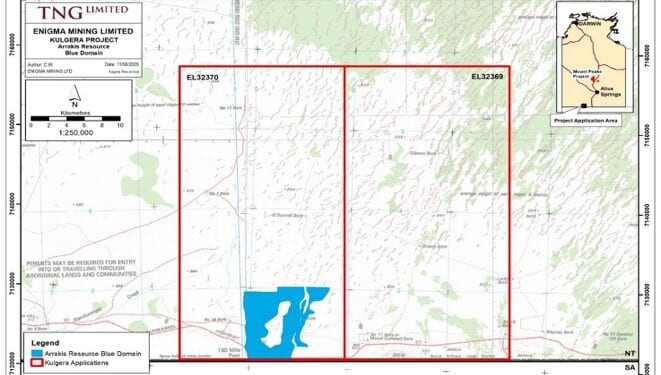Vanadium And Titanium Project Has JORC Resource
Australian resource and mineral processing technology company TNG Limited (ASX: TNG) has secured a significant strategic addition to its resource development and growth pipeline through the acquisition of a 1231 sq. km vanadium and titanium exploration project at Kulgera, located along the South Australian border in the Northern Territory in Australia.
The Kulgera Project tenure includes a maiden Mineral Resource for the Arrakis Deposit, which contains a combined JORC 2012 compliant Indicated and Inferred Resource of 346 million tonnes of dune sand with a heavy mineral fraction of 6.3% Heavy Mineralthat is dominated by ilmenite (an iron titanium oxide mineral), and could add substantially to the Mount Peake resource base.
Managing Director and CEO, Paul Burton, said TNG intends to focus any planned work programmes at Kulgera on defining concentrate that could be treated using the Company’s proprietary 100%-owned TIVAN process and conducting concentrate flowsheet refinement and TIVANTM testwork to determine the economics of extraction which could add to the Mount Peake project.
“The company’s primary focus continues to be on completion of the FEED and associated work streams for the development of its 100%-owned Mount Peake Vanadium-Titanium-Iron Project in the Northern Territory,” Mr Burton saoid.
“However, the opportunity for expansion of its tenure to include this strategic resource could potentially supplement the planned mining and processing of the Mount Peake deposit in the medium to long term, enhancing its longer-term resource development and growth pipeline and provide additional vanadium and Titanium feedstock for production, significantly enhancing its resource base.
The Kulgera Project tenements are located to the south-east of Uluru and around 120km west of the Stuart Highway.
The tenements cover 1231 sq. km of sand plain immediately on the northern boundary of the ranges of the Musgrave Province which is highly prospective for Nickel, Copper and Gold. The surficial aeolian dune sand cropping out over the tenements has significant Fe-Ti oxide content, derived from weathering of the prospective Musgrave mafic intrusive rocks to the south.
In 2012 and 2013 Globe Mineral Resources International (GMRI), outlined significant accumulations of heavy mineral sands within the dune sands but carried out no other surveys. The heavy mineral assemblage comprised both the original igneous sourced magnetite and its weathering products: ilmenite and hematite.
The elevated vanadium and titanium content of magnetite-bearing mafic intrusives from the Musgrave Province, south and west of the Kulgera Project, is well documented.
Across the border in South Australia and in far eastern Western Australia, there are large outcropping gabbroic intrusives with high magnetite contents. The intrusive mineral is vanadiferous titanomagnetite, having several thousand parts per million vanadium and several percent titanium
The magnetite/ilmenite-bearing sands identified within the project area are derived from erosion of one of these mafic intrusive bodies (the Woodroffe intrusive), some 25-40km to the south, and water and wind transport.












